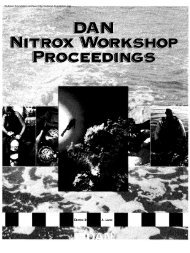Annual Diving Report - Divers Alert Network
Annual Diving Report - Divers Alert Network
Annual Diving Report - Divers Alert Network
You also want an ePaper? Increase the reach of your titles
YUMPU automatically turns print PDFs into web optimized ePapers that Google loves.
APPENDIX A. DIVE INJURY CASE REPORTS<br />
APPENDIX A. DIVE INJURY CASE<br />
REPORTS<br />
Case 1 – Infrequent teenage diver with pain and sensory symptoms<br />
that became worse during flight and partially resolved on<br />
recompression.<br />
A very fit 16-year-old male in excellent health had made 10 dives in his one year of certification.<br />
On the day of his injury, he made four dives during which he followed the divemaster. His<br />
morning dives were to 50 fsw (15 msw) for 30-35 minutes with a short safety stop, less than 45<br />
minutes on the surface, and a second dive to 30 fsw (9 msw) for about 30 minutes with a 2<br />
minutes safety stop at 15 fsw (5 msw). After a 5.5 hour surface interval, he dived to 50 fsw (15<br />
msw) for 35 minutes with no safety stop. After a 10 minute surface interval, he again dived to 50<br />
fsw (15 msw) for approximately 30 minutes with a 3 minute safety stop. The day was trouble-free.<br />
He awoke the following morning with mild joint aches that increased in the early afternoon. The<br />
aching was most noticeable in his hands, knees, ankles and feet. He then developed an<br />
uncomfortable sensation in his arms and legs and did not feel well for the remainder of the day.<br />
He had never experienced similar symptoms.<br />
At 42 hours after his last dive and 30 hours after the onset of symptoms, he flew home with his<br />
family at a cabin altitude of 6,000 ft (1,829 m). His joint pain was constant with position and<br />
movement, and he developed a slight swelling in his extremities. During the flight, the discomfort<br />
increased from a 5 to a 7-8 on a 0-10 scale. He was seen in the local hospital emergency<br />
department upon arrival that night. The odd skin sensations had resolved at the time of evaluation<br />
and no other signs or symptoms were found by the examining physician.<br />
He was recompressed on a 5 hour, U.S. Navy Treatment Table 6 with incomplete symptom relief.<br />
There was no significant change the following morning during a 2 hour treatment. His symptoms<br />
improved over the following week.<br />
Case 2 – Student diver diving at altitude with multiple symptoms that<br />
resolved with recompression 48 hours after onset.<br />
The diver was an active 32-year-old female in good health except for smoking a pack-a-day for<br />
15 years. She was taking an open-water certification course at an altitude of approximately 4,000<br />
ft (1,219 m). Her first dive was to about 20 ffw (6 mfw) for 25 minutes with a slow normal ascent<br />
followed by a 15 minute surface interval. The next dive was to 60 ffw (18 mfw) for 10 minutes with<br />
a slow ascent to 20 ffw (6 mfw) and a 3 minute safety stop followed by a 90 minute surface<br />
interval. Her final dive began at 20 ffw (6 mfw) for 5 minutes, progressed to 45 ffw (13 mfw) for 10<br />
minutes, and then to about 55 ffw (18 mfw) for 3 minutes. She surfaced after a slow ascent to 20<br />
ffw (6 mfw) over 3 minutes and a 10 minute safety stop. The total bottom time was approximately<br />
64 <strong>Annual</strong> <strong>Diving</strong> <strong>Report</strong>: 2006 Edition

















